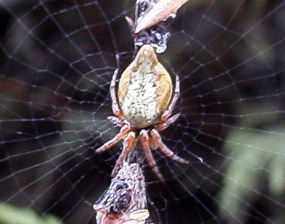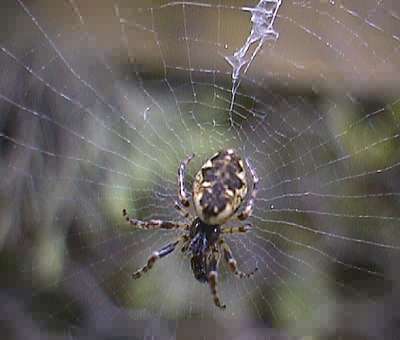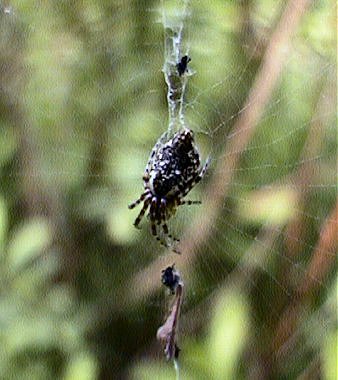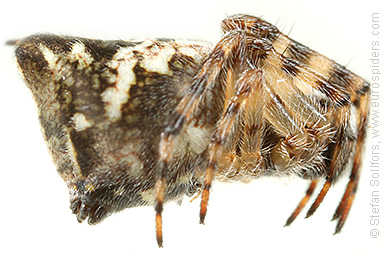Form and Functions
The Cyclosa conica is able to move like any other
spider, it moves by using a system called hydraulics.
Hydraulics is defined as a process in which power is generated
and transmitted by use of pressurized liquids (Pomeroy).
Other arthropods have extensor muscles located in their major
leg joints, but the Cyclosa conica and other spiders
don’t have these extensor muscles. Cyclosa conica
are able to extend their hind legs for movement by using
hydraulic pressure that is generated in the prosoma (anterior
part of the body) (Weihmann et al. 2012). Cyclosa
conica have muscles they are able to use to flex their
limbs inwards, but have to rely on hydraulic pressure to extend
their legs outward. While the back legs of the Cyclosa
conica are extended, to be able to move the front legs are
then shortened so that the force is passed through the leg
joints ventrally (Weihmann et al. 2012).
On the legs of the
Cyclosa conica are long hair-like structures called
trichobothria or setae. The trichobothria on the legs help
the Cyclosa conica to detect airborne vibrations and
currents. These hair-like trichobothria are useful to the
Cyclosa conica because it allows them to detect any
vibrations in their web. The trichobothria of the
Cyclosa conica are found on the tibia
 and
only on the dorsal side where the tibia is exposed to air
movements more frequently (Dudic et al. 2011). The
trichobothria on each leg are all arranged in a pattern.
Adult Cyclosa conica and their juvenile young have
different amounts of setae or trichobothria on each leg but they
both have the same trichobothrial pattern (Dudic et al. 2011).
The male and female Cyclosa conica have a difference in
their trichobothria and trochobothrial patterns. There is
a similar arrangement of setae between the male and female but
there is a difference on their
pedipalps (the second pair of
appendages that is near the mouth of the spider) (Dudic et al.
2011). The male Cyclosa conica have a smaller number of setae
on their pedipalps and also have an irregular distribution of
trichobothria. Female Cyclosa conica have a
trichobothrial pattern and distribution on their pedipalps that
is similar to the rest of their legs (Dudic et al. 2011).
and
only on the dorsal side where the tibia is exposed to air
movements more frequently (Dudic et al. 2011). The
trichobothria on each leg are all arranged in a pattern.
Adult Cyclosa conica and their juvenile young have
different amounts of setae or trichobothria on each leg but they
both have the same trichobothrial pattern (Dudic et al. 2011).
The male and female Cyclosa conica have a difference in
their trichobothria and trochobothrial patterns. There is
a similar arrangement of setae between the male and female but
there is a difference on their
pedipalps (the second pair of
appendages that is near the mouth of the spider) (Dudic et al.
2011). The male Cyclosa conica have a smaller number of setae
on their pedipalps and also have an irregular distribution of
trichobothria. Female Cyclosa conica have a
trichobothrial pattern and distribution on their pedipalps that
is similar to the rest of their legs (Dudic et al. 2011).
Decoration in the
webs is an adaptation for the Cyclosa conica to be able
to catch more prey. The Cyclosa conica is a type of orb-weaving
spider which means they decorate their web with stabilimenta, or
silk structures for decoration (Blackedge and Wenzel 1998).
The stabilimenta of the Cyclosa conica contains debris,
like the remains or dead bodies of their prey or other insects.
The use of stabilimenta in the web was generally hypothesized as
a way of camouflage, but has been found that the webs decorated
with stabilimenta also attract more insects and increases the
amount of prey. A study conducted by I-Min Tso found that
the Cyclosa conica were able to catch more prey than
other spiders with webs that were not decorated. Also from
this study, the decorated webs were able to attract and capture
almost 150% more insects than the webs without decoration (Tso
1998). Web decorating also acts as a defense mechanism for
the Cyclosa conica. Stabilimenta was found to act
as a defense against birds in a study conducted by Todd
Blackledge and John Wenzel. In the study they found that
the birds would fly towards the web, halt and then fly away
because the stabilimenta in the webs acted as a warning to the
birds (Blackedge and Wenzel 1998). The use of stabilimenta
in the webs of Cyclosa conica help the spider to
capture more prey and help as a defense against organisms that
could potentially damage their web (Tso 1998, Blackedge and
Wenzel 1998).
prey. The Cyclosa conica is a type of orb-weaving
spider which means they decorate their web with stabilimenta, or
silk structures for decoration (Blackedge and Wenzel 1998).
The stabilimenta of the Cyclosa conica contains debris,
like the remains or dead bodies of their prey or other insects.
The use of stabilimenta in the web was generally hypothesized as
a way of camouflage, but has been found that the webs decorated
with stabilimenta also attract more insects and increases the
amount of prey. A study conducted by I-Min Tso found that
the Cyclosa conica were able to catch more prey than
other spiders with webs that were not decorated. Also from
this study, the decorated webs were able to attract and capture
almost 150% more insects than the webs without decoration (Tso
1998). Web decorating also acts as a defense mechanism for
the Cyclosa conica. Stabilimenta was found to act
as a defense against birds in a study conducted by Todd
Blackledge and John Wenzel. In the study they found that
the birds would fly towards the web, halt and then fly away
because the stabilimenta in the webs acted as a warning to the
birds (Blackedge and Wenzel 1998). The use of stabilimenta
in the webs of Cyclosa conica help the spider to
capture more prey and help as a defense against organisms that
could potentially damage their web (Tso 1998, Blackedge and
Wenzel 1998).
<<Habitat
References
Reproduction>>

